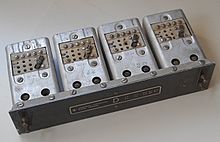National HRO

The National HRO is a historic shortwave receiver that was developed in the early 1930s by the US National Radio Company (existed from 1914 to 1991). During the Second World War it was the most widely used receiver of the radio eavesdropping ( Y-service ) of the British secret service .
history
The radio receiver went on sale in 1935 and was very popular both for military applications and among radio amateurs . There were many different models, from the HRO Junior , which was priced at $ 99, to the HRO Senior , the HRO-M and the HRO-5, to name a few, to the post-war model HRO-60 (picture) , which was priced at $ 745 for the At that time it was considered exorbitantly expensive. It was procured in quantities of about 10,000 for the United Kingdom armed forces and used by the global British Y Service (radio monitoring service) and its headquarters in Bletchley Park .
technology
The HRO is based on the heterodyne principle . It contains a heterodyne receiver consisting of nine electron tubes , which, unique at the time (1935), has a two - stage, low - noise RF preamplifier . It is characterized by a particularly high image rejection and has interchangeable sets of coils , using which it in different frequency bands between 50 kHz can be set up and 54 MHz. There are various remote power supply units ( PSU ) that protect the receiver from mains hum .
The external dimensions of the receiver are approximately 480 mm × 220 mm × 330 mm and it weighs around 22 kg.
Web links
- Scan of the original operating manual from 1939 (English, PDF, 6.4 MB)
- History of National HRO in Western Historic Radio Museum (English)
- Description of the National HRO in the Crypto Museum (English)
Individual evidence
- ↑ Description of the National HRO in the Crypto Museum (English). Retrieved March 23, 2017.
- ^ History of the National HRO at the Western Historic Radio Museum . Retrieved March 23, 2017.
- ↑ Description of the National HRO in the Crypto Museum (English). Retrieved March 23, 2017.
- ^ History of the National HRO at the Western Historic Radio Museum . Retrieved March 23, 2017.

